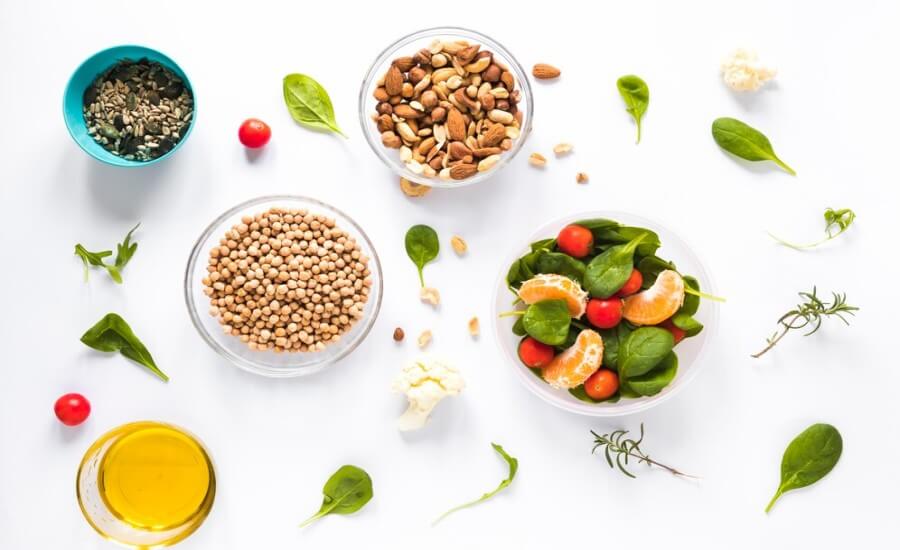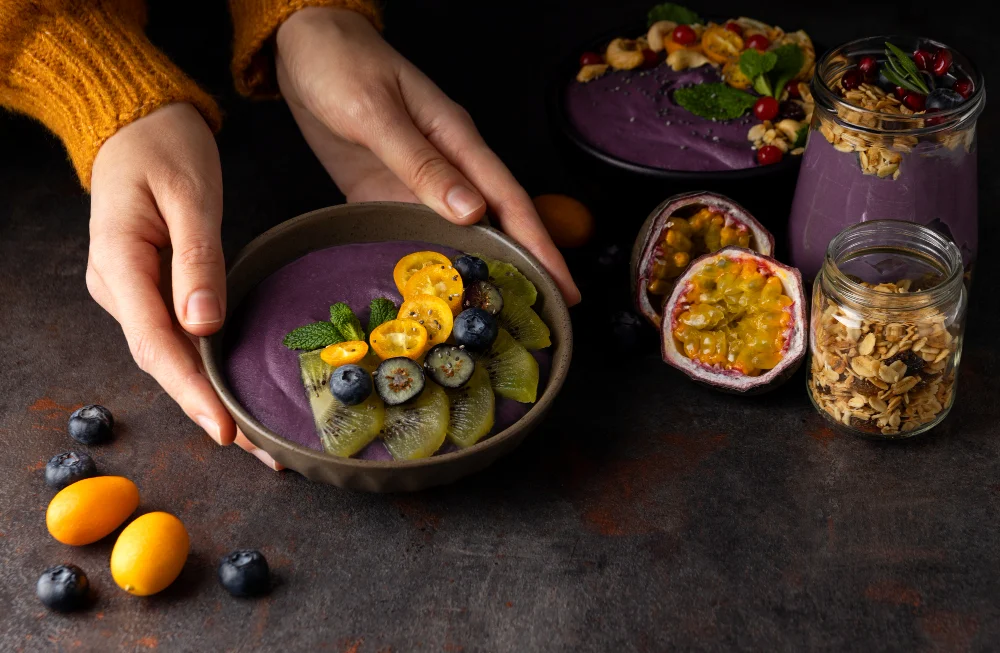Omega-3 fatty acids represent a cornerstone of human health, supporting everything from brain function and heart health to inflammation regulation and cellular integrity. This comprehensive analysis explores plant-based sources of omega-3s through multiple perspectives – nutritional biochemistry, conversion science, practical culinary applications, global accessibility, and performance optimization. By weaving together diverse fields of knowledge, we reveal how strategic incorporation of specific vegan foods can provide the full spectrum of essential omega-3s without relying on animal sources. From algae and seaweed to flaxseeds and walnuts, the plant kingdom offers remarkable omega-3 options that support cognitive function, cardiovascular health, and overall wellbeing. Understanding the science behind ALA, EPA, and DHA—and how to optimize their consumption and conversion—creates a sustainable approach to meeting omega-3 needs that aligns with both human health and environmental wellbeing through evidence-based plant-based nutrition.
Plant Power: Top Plant-Based Vegan Omega-3 Sources for Health
LENS 1: Nutritional Biochemistry
The Three Omega-3s: Understanding the Crucial Differences
Omega-3 fatty acids exist in three primary forms essential to human health, each with distinct structures and functions. While often discussed as a single nutrient, understanding the unique properties of each type is vital for optimizing plant-based nutrition.

ALA (Alpha-Linolenic Acid): The Plant World’s Omega-3 Foundation
ALA serves as the parent omega-3 fatty acid and the most abundant form in the plant kingdom. This 18-carbon fatty acid functions as the precursor from which the body can produce the other essential omega-3s through enzymatic conversion. ALA is considered an essential fatty acid because the human body cannot synthesize it—we must obtain it through diet.
Rich plant sources of ALA include:
- Flaxseeds: Among the most concentrated sources, containing approximately 2.4 grams of ALA per tablespoon of ground seeds
- Chia seeds: Providing about 5 grams of ALA per ounce, making them one of the richest plant sources available
- Walnuts: Offering approximately 2.6 grams of ALA per quarter-cup serving
- Hemp seeds: Delivering roughly 2.6 grams of ALA per three tablespoons, along with protein and other nutrients
- Perilla oil: A less common but potent source used in East Asian cuisine
Nutritional Deep Dive: Plant-Based Omega-3 Content
| Food Source | ALA Content (g) | EPA/DHA Content | Additional Nutritional Benefits |
| Flaxseeds (1 Tbsp, ground) | 2.4 | None | Lignans, fiber, protein, magnesium |
| Chia seeds (1 oz) | 5.0 | None | Fiber, calcium, phosphorus, protein |
| Walnuts (1/4 cup) | 2.6 | None | Antioxidants, protein, manganese |
| Hemp seeds (3 Tbsp) | 2.6 | None | Complete protein, magnesium, iron, zinc |
| Algal oil (300mg supplement) | Minimal | 200-300mg combined | Preformed DHA and EPA, antioxidants |
| Spirulina (1 Tbsp) | Minimal | Minimal EPA | Protein, B vitamins, iron, antioxidants |
| Seaweed (nori, 1 sheet) | Minimal | Varies by species | Iodine, vitamins B12 and C, minerals |
EPA and DHA: Long-Chain Omega-3s and Their Vital Functions
EPA (eicosapentaenoic acid) and DHA (docosahexaenoic acid) are the long-chain omega-3 fatty acids typically associated with fish oil. These 20 and 22-carbon fatty acids, respectively, play distinct and crucial roles in human health:
- DHA: Forms a significant structural component of brain tissue, retinal cells, and neuronal membranes
- EPA: Serves as a precursor to anti-inflammatory compounds and supports cardiovascular function
While traditionally considered primarily available from marine sources, both EPA and DHA can be obtained through strategic vegan food choices.
Algae stands as the most potent vegan source of omega-3 DHA. Fish actually derive their omega-3 content from consuming algae, making algae an ideal direct plant-based source. Microalgae can provide both DHA and EPA in bioavailable forms, bypassing conversion concerns entirely.
Common Misconceptions vs. Reality
Misconception: Vegans cannot get adequate EPA and DHA without fish oil. Reality: Direct plant sources of EPA and DHA exist in the form of microalgae, the original source from which fish derive their omega-3s.
Misconception: All omega-3 fatty acids have identical functions in the body. Reality: ALA, EPA, and DHA have distinct biological roles and are not interchangeable, though the body can convert between them to some extent.
Voice of Experience: The Biochemist’s Perspective
“What fascinates me about omega-3 biochemistry is the elegant conversion pathway that allows humans to transform ALA into EPA and DHA,” explains Dr. Richard Bazinet, omega-3 researcher at the University of Toronto. “While this conversion is often characterized as inefficient, it’s important to recognize that the process is dynamic and responsive to dietary patterns. The body prioritizes omega-3 conversion when intake of preformed EPA and DHA is low, such as in vegetarian and vegan diets. This adaptive capacity is particularly evident in studies showing that vegans maintain functional levels of these fatty acids despite consuming no direct sources of EPA or DHA.”
LENS 2: Conversion Science
From ALA to EPA and DHA: Understanding the Metabolic Pathway
The body’s ability to convert ALA into the longer-chain EPA and DHA forms a crucial cornerstone of plant-based omega-3 nutrition. This conversion process involves a series of enzymatic reactions with important implications for dietary planning.
Conversion Efficiency: The Science Behind the Numbers
Research shows that approximately 5% of dietary ALA converts to EPA, while less than 0.5% typically converts to DHA. While these numbers may appear low, several important considerations affect their interpretation:
- Conversion rates are not fixed but rather respond dynamically to dietary patterns and individual factors
- Total conversion depends on the amount of ALA consumed, not just the percentage converted
- The body prioritizes conversion when direct sources of EPA and DHA are limited
- Conversion efficiency varies significantly between individuals based on genetics and health status
Studies examining blood levels of omega-3s in vegans compared to omnivores provide valuable insights. Findings from the European Prospective Investigation into Cancer and Nutrition (EPIC) Study showed that women following vegan diets actually had significantly more long-chain omega-3 fats in their blood compared with fish eaters, meat eaters, and ovo-lacto-vegetarians. This suggests that conversion capacity may be more robust than previously assumed, particularly in those consistently following plant-based diets.
Conversion Science Deep Dive: Factors Affecting ALA Transformation
| Factor | Effect on Conversion | Optimization Strategy |
| Omega-6 to Omega-3 ratio | High omega-6 intake decreases conversion efficiency | Reduce processed oils high in linoleic acid (LA) |
| Total ALA consumption | Higher intake increases total EPA/DHA produced | Consume 2-4 tablespoons of ALA-rich foods daily |
| Genetic variations (FADS1/FADS2 genes) | Significant differences in conversion capacity | Those with lower conversion may benefit from direct algal sources |
| Age | Conversion typically decreases with age | Older adults may need more ALA or direct DHA/EPA |
| Biological sex | Women generally show higher conversion rates than men | Men may benefit more from direct sources |
| Health status | Certain conditions may impair conversion | Address underlying health issues |
Optimizing ALA Conversion: Practical Strategies
Several evidence-based approaches can enhance the body’s ability to convert ALA into EPA and DHA:
- Balance omega-6 to omega-3 ratio: Reducing intake of linoleic acid (LA) from sources like soybean oil, safflower oil, and corn oil can improve conversion.
- Ensure adequate micronutrients: Zinc, magnesium, and vitamins B6 and B3 serve as cofactors for conversion enzymes
- Limit trans fats: These can interfere with the enzymes involved in omega-3 metabolism
- Moderate alcohol consumption: Excessive alcohol may impair conversion capacity
- Support overall health: Inflammatory conditions and metabolic disorders can reduce conversion efficiency
Genetic Variations: The FADS1/FADS2 Connection
Genetic variations, particularly in the FADS1 gene, represent part of the dividing line in conversion ability. Carriers of the G allele for rs174537 appear to do a better job of converting ALA to DHA, while carriers of the T allele may have more trouble.
This genetic component helps explain why conversion efficiency varies significantly between individuals and populations. Some ethnic groups, including those of African and Hispanic descent, may exhibit higher conversion rates on average due to higher frequencies of efficient converter genotypes.
Voice of Experience: The Research Scientist’s Perspective
“The conversion pathway from ALA to EPA and DHA represents a fascinating example of human metabolic flexibility,” notes Dr. Susan Allport, author and omega-3 researcher. “In my research, I’ve observed that the body’s capacity to utilize ALA is remarkably adaptable. When preformed EPA and DHA are limited in the diet, conversion enzymes become more active—a classic example of biological adaptation. While direct sources of EPA and DHA from algae provide a reliable option, we shouldn’t underestimate the body’s ability to utilize plant ALA, particularly when dietary conditions are optimized through adequate intake and balanced omega-6 levels.”
LENS 3: Culinary Applications
From Theory to Table: Making Vegan Omega-3s Delicious
Transforming nutritional knowledge into appetizing daily meals represents a crucial step in optimizing omega-3 status. Strategic culinary approaches can maximize both the enjoyment and bioavailability of plant-based omega-3 sources.
Flaxseeds: Unlocking the Omega-3 Powerhouse
As one of the richest plant sources of ALA, flaxseeds deserve special attention in the omega-3 kitchen. However, if flaxseeds are not ground, they will not be digested and their nutrients will pass through the body unused. Proper preparation is essential:
- Grinding: Use a dedicated coffee grinder or high-speed blender to break the hard outer shell
- Storage: Keep ground flaxseeds in an airtight container in the freezer to prevent oxidation
- Daily use: Aim for 1-2 tablespoons daily sprinkled on oatmeal, yogurt, or smoothies
- Baking applications: Ground flaxseed can be used as an egg substitute in baking by whisking 1 tablespoon with 2.5 tablespoons of water.
- Oil considerations: Flaxseed oil should not be heated as cooking damages the ALA, but it can be drizzled on warm food or used in dressings.
Culinary Deep Dive: Creative Applications for Omega-3 Rich Foods
| Food Source | Preparation Methods | Culinary Applications | Flavor Pairings |
| Flaxseeds | Grinding, storage in freezer | Smoothies, baking, oatmeal topping | Cinnamon, berries, banana |
| Chia seeds | Soaking to form gel | Puddings, jams, smoothie thickener | Vanilla, citrus, coconut |
| Walnuts | Light toasting to enhance flavor | Snacking, salad topping, pesto base | Maple, rosemary, dark chocolate |
| Hemp seeds | Used raw to preserve nutrients | Smoothies, salad topping, homemade energy bars | Lemon, berries, dark greens |
| Seaweed | Toasting, rehydrating, or using raw | Sushi wraps, soups, salads, snacks | Sesame, ginger, citrus |
| Purslane | Used fresh in salads or lightly cooked | Salads, stir-fries, as spinach substitute | Garlic, lemon, Mediterranean herbs |
Chia Seeds: Versatile Omega-3 Gel Formers
Chia seeds offer exceptional culinary versatility alongside their omega-3 content. Their ability to absorb liquid and form a gel makes them particularly useful:
- Chia pudding: Basic ratio of 3 tablespoons seeds to 1 cup liquid, refrigerate overnight
- Egg substitute: Similar to flaxseed, useful in vegan baking
- Jam thickener: Mix with mashed fruit for quick, pectin-free preserves
- Smoothie booster: Add directly to smoothies for omega-3s and thickening
- Overnight oats: Create texture and nutrition in make-ahead breakfast
Algae and Seaweed: Bringing the Ocean’s Benefits to Land
Marine plants provide direct sources of EPA and DHA with unique culinary applications:
- Nori sheets: Seaweed offers moderate levels of vegan DHA while being rich in iodine, calcium, and magnesium. Use for sushi, wraps, or as crispy snacks
- Wakame and dulse: Add to soups, salads, and stir-fries
- Spirulina and chlorella: Spirulina is a fantastic plant-based source of EPA, and while it contains minimal DHA, it compensates with high protein concentration—up to 70% by weight. Incorporate powder into smoothies, energy balls, or homemade pasta
- Algae oil: Use as a finishing oil for salads or cold dishes, or take as a supplement
Voice of Experience: The Culinary Expert’s Perspective
“The beauty of plant-based omega-3 sources lies in their culinary versatility,” explains Matthew Kenney, plant-based chef and culinary educator. “I’ve found that the key to consistent incorporation is creating delicious ‘carrier recipes’ that feature these ingredients prominently. For instance, a weekly batch of omega-3 energy bites made with ground flax, chia, hemp seeds, and walnuts provides a convenient snack that delivers significant ALA. Similarly, a homemade seaweed gomasio (sesame salt) creates a umami-rich topping for everything from rice bowls to roasted vegetables, adding both flavor and nutrition. When these foods become craveable rather than medicinal, consistent consumption happens naturally.”
LENS 4: Global Accessibility
Beyond Specialty Stores: Omega-3s for Everyone
Access to omega-3-rich foods varies considerably across geographic regions, economic circumstances, and food cultures. A global perspective on plant-based omega-3 sources reveals the remarkable diversity of options available across different contexts.

Traditional Wisdom: Indigenous Omega-3 Sources
Long before supplements and superfoods entered the market, traditional cultures worldwide incorporated local plant sources of omega-3 fatty acids:
- Perilla leaves and seeds: Central in Korean and Japanese cuisines, perilla oil can double blood ALA levels when used regularly.
- Purslane: This often-overlooked “weed” grows globally and contains more ALA than many cultivated vegetables
- Sacha inchi: Native to the Peruvian Amazon, these seeds contain significant ALA and are traditional staples
- Lingonberries: Found in Scandinavian diets, these berries provide ALA alongside antioxidants
- Cress varieties: Watercress and garden cress feature in Mediterranean and Middle Eastern cuisines
Global Accessibility Deep Dive: Omega-3 Options Across Regions
| Region | Indigenous Omega-3 Sources | Traditional Preparations | Modern Applications |
| East Asia | Perilla, seaweed varieties | Pickled leaves, oil pressing, soup bases | Flavored oils, snack foods, supplements |
| South Asia | Mustard greens, fenugreek seeds | Saag preparations, spice mixes | Microgreen cultivation, seed oils |
| Mediterranean | Purslane, walnut | Wild gathered salads, sauces | Cultivated for restaurants, walnut oils |
| Americas | Chia seeds, black walnuts | Traditional beverages, gathered nuts | Mainstream health foods, commercial farming |
| Africa | Wild greens, moringa | Stews, dried leaf powder | Emerging superfoods, oil production |
Economic Considerations: Affordable Omega-3 Strategies
For many worldwide, expensive supplements or imported superfoods remain financially out of reach. Several cost-effective strategies can maximize omega-3 intake:
- Flaxseeds: Often the most economical omega-3 source per gram, especially when purchased in bulk
- Foraged foods: Purslane and similar ALA-rich plants grow freely in many environments
- Home cultivation: Microgreens from omega-3-rich seeds can be grown in minimal space
- Regional seed varieties: Focusing on locally available seeds reduces import costs
- Community seed sharing: Preserves access to traditional varieties with favorable omega-3 profiles
Environmental Impact: Sustainable Omega-3 Production
The environmental footprint of different omega-3 sources varies considerably:
- Microalgae cultivation: Can be produced in closed systems with minimal land and water requirements
- Seed crops: Vary in environmental impact based on farming practices and water needs
- Foraged plants: Minimal environmental impact when harvested sustainably
- Marine plants: Seaweed farming can actually benefit marine ecosystems when properly managed
Voice of Experience: The Global Nutrition Perspective
“In working with communities across different continents, I’ve observed that optimal omega-3 nutrition often already exists within traditional food systems,” shares Dr. Vandana Shiva, environmental activist and food sovereignty advocate. “For instance, in parts of the Mediterranean, wild-harvested purslane has been consumed for centuries, providing significant ALA. In Southeast Asia, perilla leaves are incorporated into countless dishes. Rather than focusing exclusively on importing trendy superfoods, honoring and preserving these traditional omega-3 sources often provides the most sustainable and culturally appropriate solution. The knowledge of which local plants provide these nutrients has been maintained through generations of traditional wisdom, and recognizing this knowledge is essential to creating truly accessible omega-3 strategies.”
LENS 5: Performance Optimization
Omega-3s for Athletes and Active Lifestyles
For those with active lifestyles, omega-3 fatty acids play particularly important roles in supporting performance, recovery, and long-term health. Strategic incorporation of plant-based omega-3s can provide significant advantages for physical performance and recovery.
Recovery Enhancement: The Anti-Inflammatory Connection
Omega-3 fatty acids, particularly EPA, help modulate the inflammatory response to exercise-induced muscle damage:
- Reduces exercise-induced inflammatory markers
- Accelerates clearance of damage byproducts
- Supports efficient tissue repair processes
- Minimizes delayed-onset muscle soreness (DOMS)
- Enables more consistent training volume
For vegan athletes, optimizing both ALA intake and conversion, while incorporating direct EPA/DHA sources when possible, creates a comprehensive recovery strategy.
Performance Deep Dive: Omega-3s for Athletic Applications
| Athletic Focus | Omega-3 Benefits | Recommended Sources | Timing Strategies |
| Endurance sports | Improved oxygen efficiency, reduced inflammation | Algae oil, flaxseed, walnuts | Daily baseline with extra during peak training |
| Strength training | Enhanced recovery, reduced soreness | Chia seeds, hemp seeds, algae supplements | Consistent daily intake with recovery meals |
| Team sports | Cognitive function, reaction time, reduced injury risk | Combined ALA sources, direct DHA/EPA | Pre-season loading, maintenance during season |
| High-impact activities | Joint health, tissue resilience | Ground flaxseed, algae oil | Daily preventive baseline |
| Mind-body practices | Mental clarity, stress management | Mixed sources with emphasis on DHA | Regular daily consumption |
Brain Function: Mental Performance Benefits
Omega-3s play crucial roles in cognitive function that extend beyond basic health to performance optimization:
- Support neurotransmitter production and reception
- Maintain neuronal membrane fluidity
- Enhance focus and attention during extended exertion
- Support mood regulation during training stress
- Protect against exercise-induced oxidative stress in neural tissue
Omega-3 fatty acids play a crucial role in maintaining optimal health, particularly benefiting our eyes, heart, and brain. In fact, 40% of the grey matter in the brain is made up of omega-3 in DHA form. This makes DHA particularly important for those whose activities require heightened cognitive performance alongside physical performance.
Personalized Approaches: Optimizing Individual Response
As with all nutrition strategies, individual response to omega-3 sources varies considerably:
- Genetic testing: Can identify FADS gene variants affecting conversion efficiency
- Blood testing: Omega-3 Index provides objective measurement of status
- Periodization: Adjusting intake based on training phases and recovery needs
- Age considerations: Conversion efficiency typically declines with age
- Integration with other recovery modalities: Synergies with sleep, stress management, and other nutritional strategies
Voice of Experience: The Sports Nutritionist’s Perspective
“Working with plant-based athletes across various sports has shown me that optimizing omega-3 status can be a genuine performance differentiator,” explains Brendan Brazier, former professional Ironman triathlete and plant-based sports nutrition pioneer. “The approach that’s proven most effective combines consistent daily ALA sources like ground flaxseed, hemp seeds, and walnuts with periodic direct EPA/DHA from algae-based supplements. This hybrid strategy ensures both immediate needs and long-term tissue saturation. For athletes with particularly high training loads or those in heavy contact sports, increasing the direct DHA/EPA component often provides noticeable recovery benefits. The key is consistency—erratic omega-3 consumption doesn’t produce the same tissue-level benefits as steady intake matched to training demands.”
Perspective Intersection Matrix
| Nutritional Biochemistry | Conversion Science | Culinary Applications | Global Accessibility | Performance Optimization | |
| Nutritional Biochemistry | — | Structural differences affect conversion pathways | Preparation methods impact bioavailability | Chemical composition varies across cultivars | Specific fatty acids have distinct performance effects |
| Conversion Science | Enzyme pathways depend on micronutrient status | — | Culinary combinations can enhance conversion | Regional diets affect baseline conversion efficiency | Athletic demands may alter conversion priorities |
| Culinary Applications | Cooking methods affect fatty acid stability | Food matrix impacts absorption and conversion | — | Traditional preparations often maximize bioavailability | Meal timing enhances performance benefits |
| Global Accessibility | Regional plant varieties have different omega-3 profiles | Genetic adaptations may match local food sources | Indigenous preparation methods preserve nutrients | — | Locally available sources can support performance needs |
| Performance Optimization | Specific ratios affect tissue incorporation | Recovery capacity linked to conversion efficiency | Practical food strategies enable consistent intake | Sustainable sources support long-term athletic development | — |
Synthesis & Recommendations
The multi-dimensional analysis of vegan omega-3 sources reveals powerful convergences across nutritional biochemistry, conversion science, culinary applications, global accessibility, and performance optimization. This integrated understanding provides a comprehensive framework for optimizing plant-based omega-3 nutrition through evidence-based, sustainable approaches.
For individuals seeking to optimize their omega-3 status through plant-based sources, consider these synthesis recommendations:
- Establish a strong ALA foundation by consuming 2-4 tablespoons of ground flaxseeds, chia seeds, or hemp seeds daily
- Incorporate direct EPA/DHA sources from algae oil or supplements, especially if you have factors that may limit conversion
- Optimize conversion efficiency by maintaining a healthy omega-6 to omega-3 ratio and limiting processed oils
- Develop enjoyable culinary applications that make regular consumption sustainable and pleasurable
- Consider your individual needs based on age, activity level, genetics, and health status
- Explore local and traditional omega-3 sources that may be more economically and environmentally sustainable
- Monitor your status periodically through testing if available, or through careful attention to potential deficiency symptoms
The remarkable diversity of plant-based omega-3 sources provides multiple pathways to optimal nutrition. By thoughtfully implementing these principles, individuals can harness the tremendous benefits of omega-3 fatty acids while aligning with plant-based values and environmental sustainability.
Further Areas of Exploration
- Emerging research on lesser-known plant sources of omega-3 fatty acids
- Genetic testing for personalized omega-3 recommendations based on FADS variants
- The interaction between gut microbiome composition and omega-3 metabolism
- Novel culinary techniques for enhancing omega-3 bioavailability in plant foods
- The role of omega-3s in specific health conditions from a plant-based perspective
- Sustainable innovation in algae-based EPA/DHA production
- Integration of traditional knowledge with modern nutritional science in omega-3 optimization












